
Son of Godzilla is a 1967 Japanese kaiju film directed by Jun Fukuda, with special effects by Sadamasa Arikawa, under the supervision of Eiji Tsuburaya. Produced and distributed by Toho Co., Ltd, it is the eighth film in the Godzilla franchise. It stars Tadao Takashima, Akira Kubo, Akihiko Hirata, and Beverly Maeda, with Hiroshi Sekita, Seiji Onaka, and Haruo Nakajima as Godzilla, and Marchan the Dwarf as Minilla.
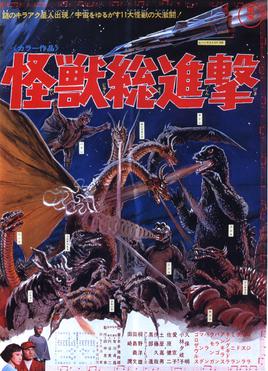
Destroy All Monsters is a 1968 Japanese epic kaiju film directed by Ishirō Honda, with special effects directed by Sadamasa Arikawa and supervised by Eiji Tsuburaya. The film, which was produced and distributed by Toho Co., Ltd, is the ninth film in the Godzilla franchise, and features eleven monster characters, including Godzilla, Mothra, Rodan, King Ghidorah, Anguirus, and Minilla. The film stars Akira Kubo, Jun Tazaki, Yukiko Kobayashi and Yoshio Tsuchiya.

Kaiju is a Japanese term that is commonly associated with media involving giant monsters. A subgenre of science fiction, it was created by Eiji Tsuburaya and Ishirō Honda. The term can also refer to the giant monsters themselves, which are usually depicted attacking major cities and battling either the military or other monsters.

Rodan is a fictional monster, or kaiju, which first appeared as the title character in Ishirō Honda's 1956 film Rodan, produced and distributed by Toho. Following its debut standalone appearance, Rodan went on to be featured in numerous entries in the Godzilla franchise, including Ghidorah, the Three-Headed Monster, Invasion of Astro-Monster, Destroy All Monsters, Godzilla vs. Mechagodzilla II and Godzilla: Final Wars, as well as in the Legendary Pictures-produced film Godzilla: King of the Monsters.

Mothra is a fictional monster, or kaiju, that first appeared in the 1961 film Mothra, produced and distributed by Toho Studios. Mothra has appeared in several Toho tokusatsu films, most often as a recurring monster in the Godzilla franchise. She is typically portrayed as a colossal sentient larva (caterpillar) or imago, accompanied by two miniature fairies speaking on her behalf. Unlike other Toho monsters, Mothra is a largely heroic character, having been variously portrayed as a protector of her own island culture, the Earth and Japan. Mothra's design is influenced by silk worms, their imagos, and those of giant silk moths in the family Saturniidae. The character is often depicted hatching offspring when approaching death, a nod to the Saṃsāra doctrine of numerous Indian religions.

Anguirus is a fictional monster, or kaiju, which first appeared in Godzilla Raids Again (1955), the second film in the Godzilla franchise. Anguirus is the first monster to be shown engaging in combat with Godzilla in a film. Since then, the character has appeared conversely as an enemy and an ally of Godzilla in numerous films produced by Toho, including Destroy All Monsters, Godzilla vs. Gigan, Godzilla vs. Megalon, Godzilla vs. Mechagodzilla, and Godzilla: Final Wars. He has also appeared in other media, including comic books and video games.

King Ghidorah is a fictional monster, or kaiju, which first appeared in Ishirō Honda's 1964 film Ghidorah, the Three-Headed Monster. The monster was initially created by Tomoyuki Tanaka, Eiji Tsuburaya and Shinichi Sekizawa as an homage to the eight-headed mythological Japanese dragon Yamata no Orochi. Although the name of the character is officially trademarked by Toho as "King Ghidorah", the character was originally referred to as Ghidorah or Ghidrah in some English markets.
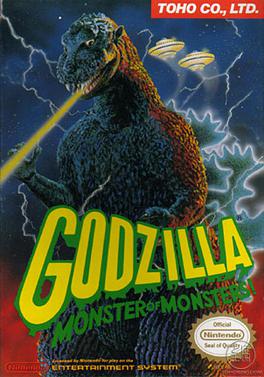
Godzilla: Monster of Monsters! (ゴジラ) is a Nintendo Entertainment System video game released in the US in 1988 by Toho Co., Ltd. The North American version removes all references to Toho Cenfile-Soft Library and Compile, crediting the game to Toho Eizo on the title screen instead.
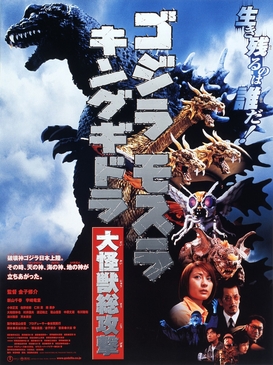
Godzilla, Mothra and King Ghidorah: Giant Monsters All-Out Attack is a 2001 Japanese kaiju film directed and co-written by Shusuke Kaneko, with special effects by Makoto Kamiya. Distributed by Toho and produced under their subsidiary Toho Pictures, it is the 26th film in the Godzilla franchise and the third film in the Millennium era. The film stars Chiharu Niiyama, Ryudo Uzaki, Masahiro Kobayashi, Hideyo Amamoto, and Shirō Sano, with Mizuho Yoshida as Godzilla, Akira Ohashi as King Ghidorah, and Rie Ōta as Baragon. In the film, Mothra, King Ghidorah, and Baragon defend Japan from Godzilla, who has been possessed by the souls of those that were killed during the Pacific War. Like the other films in the franchise's Millennium period, Godzilla, Mothra and King Ghidorah: Giant Monsters All-Out Attack serves as a direct sequel to the original 1954 Godzilla film, ignoring the events of every other installment in the series, minus a small reference to Godzilla (1998).
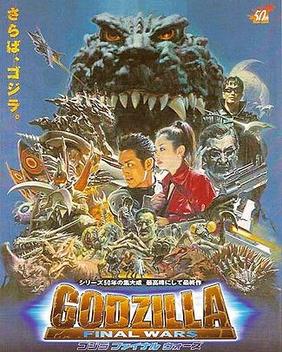
Godzilla: Final Wars is a 2004 kaiju film directed by Ryuhei Kitamura, written by Isao Kiriyama and Wataru Mimura, and produced by Shogo Tomiyama. An international co-production between Japan, Australia, the United States, and China, the film was produced by Toho Studios, CP International, Zazou Productions, and Napalm Films. It is the 29th film in the Godzilla franchise, the sixth and final film in the franchise's Millennium series and the 28th Godzilla film produced by Toho. The film stars Masahiro Matsuoka, Rei Kikukawa, Don Frye, Maki Mizuno, Kazuki Kitamura, Kane Kosugi, Kumi Mizuno, Kenji Sahara, Masami Nagasawa, Chihiro Otsuka, Shigeru Izumiya, Masakatsu Funaki, Masato Ibu, Jun Kunimura, and Akira Takarada. In the film, when a mysterious race of aliens known as the Xiliens arrive on Earth, the Earth Defense Force find themselves locked in battle with various monsters attacking cities around the world, leading them to revive the only chance to save their planet: Godzilla.

Kumonga is a mutated, enormous spider-like kaiju that first appeared in Toho's 1967 film Son of Godzilla and went on to appear in the films Destroy All Monsters, All Monsters Attack and Godzilla: Final Wars. In the English dub version of Son of Godzilla, Kumonga is referred to as Spiga, while subsequent films refer to it by its original name.
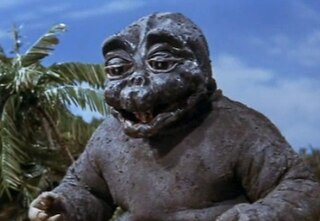
Minilla is a kaiju who first appeared in Toho's 1967 film Son of Godzilla. He is the adopted son of Godzilla, and is sometimes referenced as Minya in the American dubbed versions.

Varan is a fictional monster, or kaiju, that first appeared in the 1958 film Giant Monster Varan, directed by Ishirō Honda and produced and distributed by Toho. Varan is depicted as a giant prehistoric reptile capable of gliding flight, and has gone on to appear in the 1968 film Destroy All Monsters, the ninth film in the Godzilla franchise.

Baragon is a fictional monster, or kaiju, which first appeared in Ishirō Honda's 1965 film Frankenstein vs. Baragon, produced and distributed by Toho. Depicted as a burrowing, four-legged, horned dinosaur-like creature with large ears, Baragon appeared alongside Godzilla and other monster characters in films in the Godzilla franchise, also produced by Toho, including Destroy All Monsters and Godzilla, Mothra and King Ghidorah: Giant Monsters All-Out Attack.

Manda (マンダ) is a fictional monster, or kaiju, which first appeared in Ishirō Honda's 1963 film Atragon, produced and distributed by Toho. Manda is based on a Japanese dragon, and is depicted as a giant sea-dwelling serpent which can survive on land. Manda's roars were created through recordings of lions bellowing.

Godzilla Island is a television show spinoff of the Godzilla franchise. It premiered on October 6, 1997, and ran for a total of 256 three-minute episodes, finishing on September 30, 1998.
Godzilla is a novel series written by author Marc Cerasini based on the film series's characters. While all set within the same continuity, each novel has its own plot and storyline, with Toho's kaiju featured as the stars.
Godzilla is a series of children's novels about Godzilla, the Japanese movie monster, by Scott Ciencin.

Kaijū-ō Godzilla is a 1993 action adventure game by Bandai for the Game Boy. It was released exclusively in Japan. The game is notable for featuring nearly every monster in the Godzilla franchise up until the time of its release.
















